|
|
|
Sort Order |
|
|
|
Items / Page
|
|
|
|
|
|
|
| Srl | Item |
| 1 |
ID:
180095
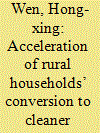

|
|
|
|
|
| Summary/Abstract |
This study investigated the existence of peer effects in the diffusion of clean cooking fuels among rural households in China and identified the mechanisms by which these peer effects were enacted from the perspective of social networks. We observed greater adoption of clean cooking fuels in areas in which adoption was already relatively high, however, this peer spill-over decreased over time and was regulated by the accessibility and strength of social networks. Specifically, if a household's social circle was more extensive or its communication with neighbours, relatives, and friends was closer, its choice of a clean cooking fuel was more likely to be affected by its peer groups. To stimulate stronger peer spill-over, we suggest that interventions such as strengthening social interactions across rural households should be included in the government's strategy to help more households convert to cleaner cooking fuels.
|
|
|
|
|
|
|
|
|
|
|
|
|
|
|
|
| 2 |
ID:
125766


|
|
|
|
|
| Publication |
2013.
|
| Summary/Abstract |
Karnataka has been among the most successful markets for solar lighting systems (SLS) among Indian states. In order to understand the dynamics of systems adoption and operation, that have fostered market based adoption of solar lighting, we interviewed rural households from six districts that had purchased solar lighting systems using loans at market rates, the rural banks that provided loans and the solar firms that marketed the technology. We found that a large proportion of households in our sample were connected to the grid but chose to install solar lighting because they considered the power supply from the grid to be unreliable. Households in our sample reported savings on electricity costs and reduced kerosene usage for lighting. In addition to providing credit, banks also play a key role in ensuring good service and maintenance; the viability of the SLS market is thus critically dependent on the role that the banks play as intermediaries between consumers and solar firms in rural areas. Government programs should be carefully designed to match the incentives of firms, banks and consumers if the successes of the 'Karnataka model' are to be repeated and amplified.
|
|
|
|
|
|
|
|
|
|
|
|
|
|
|
|
| 3 |
ID:
094962
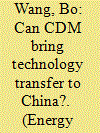

|
|
|
|
|
| Publication |
2010.
|
| Summary/Abstract |
China has undertaken the greatest number of projects and reported the largest emission reductions on the global clean development mechanism (CDM) market. As technology transfer (TT) was designed to play a key role for Annex II countries in achieving greenhouse gas emission reductions, this study examines various factors that have affected CDM and TT in China. The proportion of total income derived from the certified emissions reductions (CER) plays a key role in the project owners' decision to adopt foreign technology. Incompatibility of CDM procedures with Chinese domestic procedures, technology diffusion (TD) effects, Chinese government policy and the role of carbon traders and CDM project consultants all contribute to the different degrees and forms of TT. International carbon traders and CDM consultants could play a larger role in TT in China's CDM projects as investors and brokers in the future.
|
|
|
|
|
|
|
|
|
|
|
|
|
|
|
|
| 4 |
ID:
105278
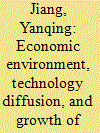

|
|
|
|
|
| Publication |
2011.
|
| Summary/Abstract |
This paper examines the effects of the regional economic environment and technology diffusion on China's regional total factor productivity (TFP) growth. We build a model of TFP growth in which Chinese regions achieve growth in TFP by making use of technology spillovers from the world technology frontier. We hypothesize that given the world frontier level of TFP, China's regional TFP growth is positively related to regional openness and negatively related to the current level of regional TFP. Empirical analysis in this paper of 29 province-level regions in China strongly supports our hypothesis. By using a nonlinear least squares regression method, we show that regional openness has a significantly positive effect on regional TFP growth. As a by-product, we also estimate a value of the output elasticity of capital that conforms to its traditionally accepted values. The findings of this paper lend strong support to the claim that the opening up process of China promotes the country's economic growth.
|
|
|
|
|
|
|
|
|
|
|
|
|
|
|
|
| 5 |
ID:
096096


|
|
|
|
|
| Publication |
2010.
|
| Summary/Abstract |
Micro-cogeneration (micro-CHP) is a new technology at the household level, producing electricity in cogeneration with domestic heating, thereby increasing the overall efficiency of domestic energy production. We have developed a prototypical agent-based simulation model for energy technologies competing for demand at the consumer level. The model is specifically geared towards the competition between micro-CHP and incumbent condensing boilers. In the model, both technologies compete on purchase price and costs of usage, to which various (types of) consumers decide on the installation of either technology.
Simulations with various gas and electricity prices show that micro-CHP diffusion could be seriously inhibited if demand for natural gas decreases, e.g. due to insulation measures. Further simulations explore various subsidy schemes. A subsidy for purchase is only found to be effective within a limited range of €1400-3250. A subsidy based on decreasing price difference between the competing technologies is much more cost effective than fixed purchase subsidies. Simulations of a subsidy scheme for usage show that a fast market penetration can be reached, but this does not yet take full advantage of technological progress in terms of decreasing CO2 emissions. Selection of the most effective scheme thus depends on the policy criteria assumed.
|
|
|
|
|
|
|
|
|
|
|
|
|
|
|
|
| 6 |
ID:
132827


|
|
|
|
|
| Publication |
2014.
|
| Summary/Abstract |
This study challenges the implicit assumption of homogeneity in national institutional contexts made in past studies of (renewable) energy policy. We propose that institutional differences matter by focusing on several technology-specific and generic policy factors that can foster technology diffusion through private sector activity. More specifically, we explore perceptions of early adopters in emerging economy contexts using wind park project developers as an example. By applying a parsimonious method for our questionnaire as well as qualitative data we make several contributions: Methodologically, we introduce Maximum Difference Scaling to the energy policy domain. Empirically, we identify several public influences on private investment, and assess their relative importance. This leads to new insights challenging findings from industrialized economies; we identified additional institutional barriers to diffusion, hence, the requirement of a combination of technology-specific and generic policy measures.
|
|
|
|
|
|
|
|
|
|
|
|
|
|
|
|
| 7 |
ID:
178844


|
|
|
|
|
| Summary/Abstract |
We introduce a new bottom-up model for simulating Future Technology Transformations in the European residential heating sector, FTT:Heat. The model simulates the uptake and replacement of heating technologies by households in all individual Member States up to 2050, and allows to simulate the potential effect of real-world policy instruments aiming at an increased uptake of low-carbon technologies. It features an explicit representation of households' technology choices, based on observed preferences and non-linear diffusion dynamics. Decision-makers are modelled as individual households, which are subject to limited information and bounded rationality. Their decisions reflect behavioural factors and preferences at the micro level, and may result in sub-optimal outcomes from a macroeconomic perspective. For demonstration, we simulate policy mixes for reaching the EU's 2030 renewable heating targets in each Member State. Under current diffusion trends, some countries are estimated to continue an ongoing transition towards renewable heating, while others would hardly see any decarbonisation. For increasing the share of renewable heating by at least ten percentage points until 2030, 20 Member States need to introduce additional policies, the necessary stringency of which differs between countries. Due to the slow turnover of heating systems, resulting cost increases faced by households could persist over decades.
|
|
|
|
|
|
|
|
|
|
|
|
|
|
|
|
| 8 |
ID:
166559
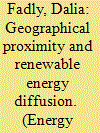

|
|
|
|
|
| Summary/Abstract |
In an era where achieving both economic growth and environmental sustainability is paramount, the role of technology diffusion remains an important one. Recent literature explores the link between geographical proximity and the adoption and diffusion of climate change adaptation policies. However, it has generally focused on a restricted set of developed countries and focused on the diffusion of policy instrument rather than the outcome of the policies. In this paper, we argue that domestic intensity of adoption of renewable energy technologies is likely to be affected by the adoption pattern in neighbouring countries. Additionally, this effect is likely to be stronger when important trade partners are intensive adopters of renewable energies. To test these hypotheses, we construct an index that captures a distance-weighted measure of intensity of renewable energies in other countries and apply a fixed effects framework to a panel of up to 116 countries over the (1980–2012) period. Our results confirm the existence of a geographic spill-over effect on the intensity of adoption of renewable energy technologies. Moreover, this effect is stronger when intensive adopters of renewable energies are also important trading partners, highlighting the relevance of trade channel as a potential catalyst of the diffusion of renewable energies across countries.
|
|
|
|
|
|
|
|
|
|
|
|
|
|
|
|
| 9 |
ID:
069860


|
|
|
| 10 |
ID:
111406


|
|
|
|
|
| Publication |
2012.
|
| Summary/Abstract |
This paper examines whether the Kyoto mechanisms have stimulated the diffusion of renewable energy technologies in the BRICS, i.e. Brazil, Russian, India China and South Africa. We examine the patterns of diffusion of renewable energy technologies in the BRICS, the factors associated with their diffusion, and the incentives provided by the Kyoto mechanisms. Preliminary analysis suggests that the Kyoto mechanisms may be supporting the spread of existing technologies, regardless if such technologies are still closely tied to environmental un-sustainability, rather than the development and diffusion of more sustainable variants of renewable energy technologies. This raises questions about the incentives provided by the Kyoto mechanisms for the diffusion of cleaner variants of renewable energy technologies in the absence of indigenous technological efforts and capabilities in sustainable variants, and national policy initiatives to attract and build on Kyoto mechanism projects. We provide an empirical analysis using aggregated national data from the World Development Indicators, the International Energy Agency, the United Nations Framework Convention on Climate Change and secondary sources.
|
|
|
|
|
|
|
|
|
|
|
|
|
|
|
|
| 11 |
ID:
101415


|
|
|
|
|
| Publication |
2011.
|
| Summary/Abstract |
New fuel economy standards require new U.S. passenger vehicles to achieve at least 34.1 miles per gallon (MPG) on average by model year 2016, up from 28.8 MPG today. In this paper, the magnitude, combinations and timings of the changes required in U.S. vehicles that are necessary in order to meet the new standards, as well as a target of doubling the fuel economy within the next two decades are explored. Scenarios of future vehicle characteristics and sales mix indicate that the 2016 mandate is aggressive, requiring significant changes starting from today. New vehicles must forgo horsepower improvements, become lighter, and a greater number will use advanced, more fuel-efficient powertrains, such as smaller turbocharged engines, hybrid-electric drives. Achieving a factor-of-two increase in fuel economy by 2030 is also challenging, but more feasible since the auto industry will have more lead time to respond. A discussion on the feasibility of meeting the new fuel economy mandate is included, considering vehicle production planning realities and challenges in deploying new vehicle technologies into the market.
|
|
|
|
|
|
|
|
|
|
|
|
|
|
|
|
| 12 |
ID:
097343


|
|
|
|
|
| Publication |
2010.
|
| Summary/Abstract |
As climate change mitigation gains attention in the United States, low-carbon energy technologies such as wind power encounter both opportunities and barriers en route to deployment. This paper provides a state-level context for examining wind power deployment and presents research on how policy stakeholders perceive wind energy in four states: Massachusetts, Minnesota, Montana, and Texas. Through semi-structured interviews, state-level energy policy stakeholders were asked to explain their perceptions of wind energy technology within their state. Interview texts were coded to assess how various drivers promote or hinder the deployment of wind power in sub-national contexts. Responses were dominated by technical, political, and economic frames in all four states, but were often driven by a very different rationale. Environmental, aesthetic, and health/safety frames appeared less often in the discourse. This analysis demonstrates that each state arrived at its current level of deployment via very different political, economic, and technical paths. In addition to helping explain why and how wind technology was - or was not - deployed in each of these states, these findings provide insight into the diversity of sub-national dialogues on deployment of low-carbon energy technologies.
|
|
|
|
|
|
|
|
|
|
|
|
|
|
|
|
| 13 |
ID:
090332
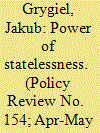

|
|
|
| 14 |
ID:
186875
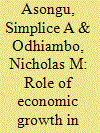

|
|
|
|
|
| Summary/Abstract |
This study establishes economic growth needed for supply-side mobile money drivers in developing countries to be positively related to mobile money innovations in the perspectives of mobile money accounts, the mobile phone used to send money, and the mobile phone used to receive money. The empirical evidence is based on Tobit regressions. For the negative net relationships that are computed, minimum economic growth thresholds are established above which the net negative relationships become net positive relationships. The following minimum economic growth rates are required for nexuses between supply-side mobile money drivers and mobile money innovations to be positive: (i) 6.109 percent (6.193%) of Gross Domestic Product (GDP) growth for mobile connectivity performance to be positively associated with the mobile phone used to send (receive) money and (ii) 4.590 percent (4.259%) of GDP growth for mobile connectivity coverage to be positively associated with the mobile phone used to send (receive) money.
|
|
|
|
|
|
|
|
|
|
|
|
|
|
|
|
| 15 |
ID:
105044


|
|
|
|
|
| Publication |
2011.
|
| Summary/Abstract |
We develop a model of military technology competition among states. States can choose to introduce new military technology, mimic rivals' level of technology, or withdraw from the contest. States can choose to implement any level of technology within their current feasible technologies. We find that states with significant technological leads should sometimes withhold new technologies, only strategically releasing them to trump rivals' efforts. We develop the model by refining Admiral Jackie Fisher's roughly articulated concept of 'plunging'. We then use this refined argument to reanalyze the case of naval rivalries among European powers between the Crimean War and the First World War. Finally, we conclude by discussing the model's implications for current US military force structure planning.
|
|
|
|
|
|
|
|
|
|
|
|
|
|
|
|
| 16 |
ID:
097279


|
|
|
|
|
| Publication |
2010.
|
| Summary/Abstract |
The German government has developed a variety of policy instruments intended to reduce national CO2 emissions. These instruments include a programme administered by KfW bank, which aims at improving the energy efficiency of buildings. It provides attractive credit conditions or subsidies to finance refurbishment measures which improve the energy efficiency of buildings significantly.
The refurbishment programme leads to a reduction in energy use, which benefits private investors by reducing their energy bills. In order to estimate whether the programme benefits society as a whole, additional effects must be taken into account, such as the amount of employment generated and the impact on the public budget.
The aim of this paper is to evaluate the social benefits of the German CO2 refurbishment programme for the years 2005-2007. An extended input-output model is used to estimate the effect of the refurbishment works on public revenue via taxes and social security contributions. The value of avoided CO2 emissions is approximated using a range of marginal damage estimates from the literature. From these social benefits, the programme cost is deducted. The net social benefit thus computed turns out to be positive. This finding suggests that the refurbishment programme is a reasonable investment of public funds.
|
|
|
|
|
|
|
|
|
|
|
|
|
|
|
|
| 17 |
ID:
124396
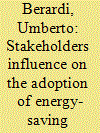

|
|
|
|
|
| Publication |
2013.
|
| Summary/Abstract |
The instability and fragmentation of the temporary aggregations of many stakeholders in construction processes are barriers to adopting new technologies. This paper investigates the influence of different stakeholders on the adoption of mature energy-saving technologies in new residential buildings. Recent literature about the influence of different stakeholders on construction processes is reviewed focusing in their interest for energy saving technologies. To gain an insight into the specific roles played by stakeholders (general contractors, construction firms, architects, users and public governments) in different projects, a case study methodology was used. The influence on the adoption of energy-saving technologies of stakeholders was assessed through semi-structured interviews. These interviews focused on the interest and power for the adoption of several energy-saving technologies. Having recognized that the interest in adoption is often expressed late in the construction processes, the time of introduction of this interest was assessed. This paper provides an empirical insight into significant barriers for the adoption of energy saving technologies which are the low influence of highly motivated stakeholders on the decision of adoption, and the delay at which the interest in energy-saving technologies emerges. Finally, policies to overcome these barriers are suggested.
|
|
|
|
|
|
|
|
|
|
|
|
|
|
|
|
| 18 |
ID:
094208


|
|
|
|
|
| Publication |
2010.
|
| Summary/Abstract |
In 2009 the U.S. federal government enacted tax credits aimed at encouraging consumers to purchase plug-in hybrid electric vehicles (PHEVs). These tax credits are available to all consumers equally and therefore do not account for the variability in social benefits associated with PHEV operation in different parts of the country. The tax credits also do not consider variability in consumer income. This paper discusses why the PHEV subsidy policy would have higher social benefits at equal or less cost if the tax credits were offered at different levels depending on consumer income and the location of purchase. Quantification of these higher social benefits and related policy proposals are left for future work.
|
|
|
|
|
|
|
|
|
|
|
|
|
|
|
|
| 19 |
ID:
132742


|
|
|
|
|
| Publication |
2014.
|
| Summary/Abstract |
Turkey's energy demand has been growing by 4.5% per year over the last decade. As a reaction to this, the Turkish government has implemented the Strategic Energy Efficiency Plan (SEEP), which provides a guideline for energy efficiency policies in all sectors.
The aim of this study is to analyse the potential of the SEEP on final energy demand in the Turkish residential sector until 2030. Three scenarios are developed based on a detailed bottom-up modelling approach using a vintage stock model to simulate the energy demand of heating systems and appliances.
The results show a decreasing final energy demand in the reference scenario from about 944 PJ in 2008 to 843 PJ in 2030. This reflects a structural break, which is mainly caused by a high building demolition rate and low efficiency in the existing building stock. The SEEP achieves additional savings of around 111 PJ until 2030, while a scenario with even higher efficiency shows further savings of 91 PJ. Electricity demand increases in all scenarios - mainly due to growing ownership rates of appliances. The SEEP will achieve around 10 TWh of electricity savings in 2030 compared to the reference scenario, mainly through more ambitious end-use standards.
|
|
|
|
|
|
|
|
|
|
|
|
|
|
|
|
| 20 |
ID:
171489


|
|
|
|
|
| Summary/Abstract |
Natural gas vehicles (NGV) face significant adoption barriers in Jakarta. Therefore, a successful transition requires measures from the government. Owing to the high cost of transition policies, the efficacy of these policies must be analyzed to identify the most effective policy. The implementation of transition policies, however, could dynamically influence people's perception and behavior, which then changes the landscape of adoption barriers. Furthermore, even a seemingly successful policy may fail when a certain pathway of uncertainties emerges in the future. To address these concerns, we integrated agent-based modeling, exploratory modeling, and diffusion of innovation theory into the exploratory model-based diffusion analysis approach. This approach evaluates the policy's performance, explores changes in the relative importance of different adoption barriers, and identifies policy vulnerabilities, i.e., scenarios leading to policy failures. We tested this approach on four NGV transition policies targeting three adoption barriers. We found that the importance of adoption barriers and the critical uncertainties upon the implemented policies. The social–behavioral barrier predominates under current conditions, whereas the economic factor becomes more relevant when all policies are executed. Understanding the changes in adoption barriers and policy vulnerabilities will help decision-makers to prepare additional measures that ensure a successful transition.
|
|
|
|
|
|
|
|
|
|
|
|
|
|
|
|
|
|
|
|
|